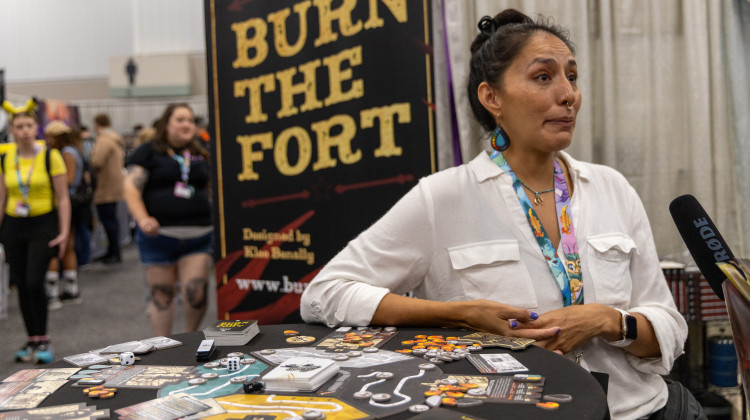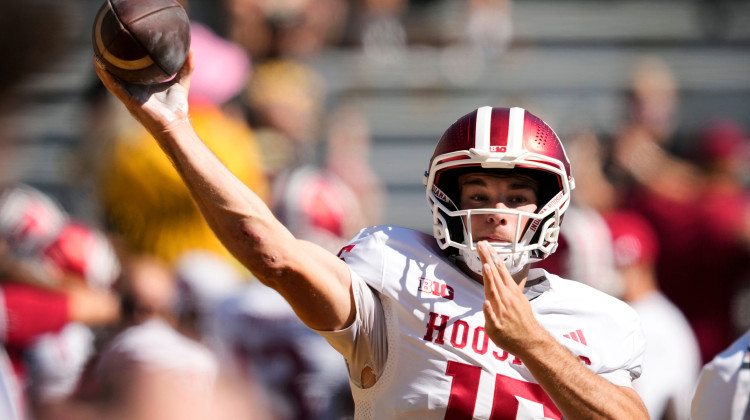
Princess Benally talks about her late-husband’s game about colonialism through the Indigenous perspective.
Zach Bundy / WFYIFor four-days gamers from across the world converged at Gen Con, known to be one of the largest tabletop gaming conventions.
The convention has continually grown over the years setting record attendance numbers with the expectation of 2020 when the in-person event was canceled due to the COVID-19 pandemic. This year more than 71,000 people purchased passes for the sold out event.
With the rapid growth, organizers of the event have also focused on making the event more inclusive. That includes creating spaces for people of color to meet and network, quiet spaces for those with sensory needs, and grants to bring underrepresented groups to the convention that otherwise would have been unaffordable.
“All these efforts over the years have really kind of created a much more open environment,” said David Hoppe, President of Gen Con. “And I think everybody benefits from it. Everybody has a better time.”
Historical lack of diversity
The board game industry has been historically a white male dominated space, from creators to enthusiasts. Elizabeth Hargrave started designing games in 2014.
“I really felt it as I was starting to get involved in like, play testing my games, and going to play testing events and designer oriented events that I would sometimes be the only woman in the room,” Hargrave said.
Today she said she sees a more 50/50 split amongst men and women who play as well as many gender nonconforming people. But that level of representation is not seen amongst game creators.
Hargrave doesn’t believe the industry is actively discriminating against underrepresented groups any more than other industries, but rather a history of games catering to who was considered the traditional tabletop gamers.
“My concern is that there's a feedback loop, that if we aren't getting a diverse set of designers making games and publishing the games and art directing the games, then those games that are getting made are probably appealing to the the folks who are making them and maybe not as appealing to other demographics,” she said.
Moving the needle
When there isn’t diverse representation, negative tropes show up on the table. One example is the depiction of Indigenous people in games.
“We see a lot of games where it is about colonization, going to another, you know, area and like taking that over, or using Indigenous folks as NPCs (Non-player characters), or as tertiary characters as resources to be traded with,” said Princess Benally.
Benally was at Gen Con this year promoting her late husband’s game, Burn the Fort. Wedged in the packed aisles of the convention center, she demonstrated the game to interested onlookers walking them through how to play. Her husband and her are both Navajo.
“With this game, he also wanted to be able to tell the history of Indigenous folks during the so-called American Indian Wars, and have younger folks be able to do that through a board game to be able to interact and talk about some of these things.”
She says it’s important to break away from the historical tropes indigenous people have had in board games and see issues from other viewpoints.
“There are some folks who are just like, Well, why would I want to attack wagons?” Benally said. “Well, let's talk about some of these things.”
Bringing unique and overlooked perspectives into the tabletop gaming community has been something Gen Con has heavily invested in over the past few years.
That includes the Gen Con Participation Grants Program. The grants help people from underrepresented groups attend the convention by covering the four-day pass and a stipend for hotel and food expenses. Currently about 50 people are awarded the grant.
In 2022 there were about 60 applications. This year, there were more than 200.
Gen Con president David Hoppe hopes the grantees attend the convention and see a future for themselves in the industry.
“Ultimately, we don't want to just, you know, fill our attendee base, but we really want to see more, more creators, more participants, more publishers, game designers, exhibitors, we want to really highlight some of these amazing creative voices that are out there,” Hoppe said.
Convention organizers have also created spaces for people to connect. One space is the BIPOC lounge that provides a room dedicated for people of color to connect, network and receive mentoring.
“People of color have told us, they walk into that room, and they suddenly feel like, ‘Okay, now I really belong here, not just in this room, but I belong in the entire convention,’” Hoppe said. “And that's really important to us, because it's easy for one bad experience can make somebody really feel bad about coming here.”
The space is in collaboration with The Rose Gauntlet Foundation, an organization that works to uplift marginalized voices in the tabletop gaming industry.
Rina Amaranthine is the mentorship chair for the foundation. As a game designer themself, Amaranthine was excited the inclusive space was able to not only have mentorship meeting rooms but also offer playtesting opportunities.
“Our designers of color have been able to bring in their newly launched or about to launch games, playtest them with like, real people off the street, and get that feedback like in real time, which is really great,” they said.
Progress, but more still needs to be done
Organizers of Gen Con say while they are seeing improvements to diversity and representation at the event, they plan to continue to review and improve the convention for future years.
“All these efforts over the years have really kind of created a much more open environment,” Hoppe said. “And I think everybody benefits from it.”
Nala J. Wu is the Art Director at publisher Hunter Entertainment. They want to use their leadership position to help other unrepresented artists.
“It's amazing because I am in a position of power to hire diverse artists who have diverse voices, and every day I get to facilitate the creation of really cool, diverse art that I'm really hoping is pushing the boundaries of the standard of art in the space,” Wu said.
They said having games with diverse perspectives can play an important role in our society.
“I believe games and things like this can teach empathy,” Wu said.
Game designer Elizabeth Hargrave notes the momentum for more representation in tabletop games. But even with all the progress made, there are areas still falling short.
“You see it in the text of old rulebooks, especially ones that have been translated from foreign languages. Often, the entire text of a rulebook will talk about players as if they're male,” Hargrave said. “So there's subtle things like that, that not everyone notices. But once you do start to notice, it's, it's everywhere.”
 DONATE
DONATE






 Support WFYI. We can't do it without you.
Support WFYI. We can't do it without you.